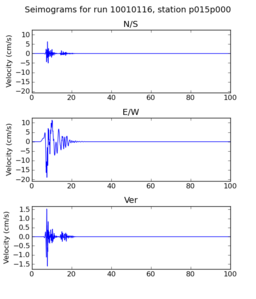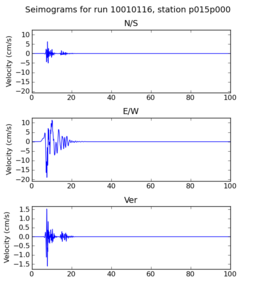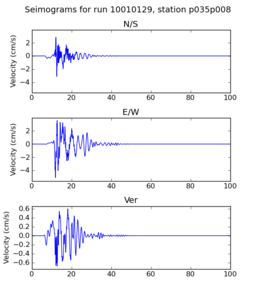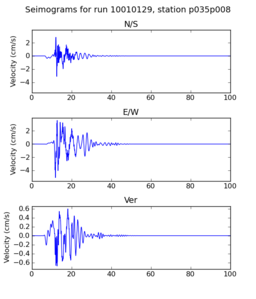Fling Study
Contents
Overview
The Fling study is a set of broadband platform simulations defined by PG&E and PEER researchers and run by SCEC Broadband platform group. Full specification of the Fling study will be posted when available.
Fling Study Scenario List
scenario_id magnitude dip rake Ztor fault_length fault_width Priority 101 6 90 180 0 14 8 1 102 6.5 90 180 0 24 13 103 7 90 180 0 68 15 104 7.5 90 180 0 210 15 105 7.8 90 180 0 420 15 106 8.2 90 180 0 470 15 107 6 70 180 0 14 8 2 108 6.5 70 180 0 24 13 109 7 70 180 0 68 15 110 7.5 70 180 0 210 15 111 7.8 70 180 0 420 15 112 8.2 70 180 0 470 15 113 6 70 180 0 14 8 3 114 6.5 70 180 0 24 13 115 7 70 180 0 40 25 116 7.5 70 180 0 100 32 117 7.8 70 180 0 160 40 118 8.2 70 180 0 400 40 119 6 90 180 0 14 8 4 120 6.5 90 180 0 24 13 121 7 90 180 0 40 25 122 7.5 90 180 0 100 32 123 7.8 90 180 0 160 40 124 8.2 90 180 0 400 40 125 6 45 90 0 10 10 5 126 6 45 90 5 10 10 127 6.5 45 90 0 18 18 128 6.5 45 90 5 18 18 129 7 45 90 0 44 23 130 7.5 45 90 0 126 25 131 7.8 45 90 0 180 25 132 6 60 90 0 10 10 133 6 60 90 5 10 10 134 6.5 60 90 0 18 18 135 6.5 60 90 5 18 18 136 7 60 90 0 50 20 137 7.5 60 90 0 150 20 138 7.8 60 90 0 200 20 139 7.0 45 90 0 18 18 140 6.5 45 90 0 18 18 141 6.5 45 90 5 18 18 142 7.0 45 90 0 44 23
Notes
Engineers have put together a set of fling simulations to submit to the BB Platform as shown in the list above.
Scenarios 140, 141 and 142 were identified as high priority simulations at a NGA-West2 meeting last Friday.
Running on USC HPCC
A sample set of simulations from the Fling study were run on USC HPCC. The original fling generation scripts, source descriptions, station lists, and batch scripts were copied over from broadband.usc.edu to /home/rcf-104. Then small modifications were made to update paths and block the actual execution of the platform (the platform will be run in a PBS job):
Sample scripts can be found at the following locations:
| Script | Location | Description | Modified |
|---|---|---|---|
| build_xml.py | /auto/rcf-104/patrices/bbp/batch_tools | Builds XML workflows for a simulation | No |
| batch_run_bbp.py | /auto/rcf-104/patrices/bbp/batch_tools | Executes BBP workflow | Modified to only write BBP command-lines for simulations to a log for later execution by run_parallel.py. BBP invocations are saved in batch_run_bbp_sims.log and bbp output directory moves are saved in batch_run_bbp_moves.log |
| run_parallel.py | /auto/rcf-104/patrices/bbp/batch_tools | Helper script to run N programs on a set of M cores | New script |
| gen_source_input.csh | /auto/rcf-104/patrices/bbp/fling | Generate full study inputs | No |
| run_bbp-parallel.csh | /auto/rcf-104/patrices/bbp/fling | Originally intended to execute the study with the platform. After modifications, only generates XML and execution lists for run_parallel.py. | Some paths changed, also added ${ROOT_PATH} to some relative path locations to make them absolute paths |
General steps for running the Fling study:
- Generate inputs
$ ./gen_source_input.csh
- Generate XML workflows
$ ./run_bbp-parallel.csh
- Create PBS job submission script (example below)
- Submit PBS job to USC HPCC
Example PBS script running the sample Fling simulations on 16 cores:
#!/bin/bash #PBS -q nbns #PBS -l arch=x86_64,pmem=2000mb,pvmem=3000mb,walltime=6:00:00,nodes=4:ppn=4 #PBS -V #PBS -e /home/rcf-104/patrices/bbp/fling/Xml1/Set1/run_set1.err #PBS -o /home/rcf-104/patrices/bbp/fling/Xml1/Set1/run_set1.out PYTHONPATH=/home/rcf-104/patrices/bbp/11.2.2/bbp_2g/comps HOME=/home/rcf-104/patrices/bbp/fling echo "Jobs start" date cd $HOME python $HOME/Xml1/Set1/run_parallel.py /home/rcf-104/patrices/bbp/11.2.2/setup_bbp_env.sh $HOME /Xml1/Set1/batch_run_bbp_sims.log $PBS_NODEFILE 1 python $HOME/Xml1/Set1/run_parallel.py /home/rcf-104/patrices/bbp/11.2.2/setup_bbp_env.sh $HOME /Xml1/Set1/batch_run_bbp_moves.log $PBS_NODEFILE 1 echo "Jobs end" date
Comparison of Seismogram from Server and Cluster
| Simulation | broadband.usc.edu | USC HPCC cluster |
|---|---|---|
| 10010116 | ||
| 10010129 |
Certification of USC HPCC Cluster for Broadband Calculations
The verification and validation of the currently released Broadband platform is based on results generated on a SCEC server called broadband.usc.edu. When we move the Broadband platform software, re-build it, and re-run it in a different computing environment, the results the platform produces can be slightly different than results produced on the SCEC server. Differences can come from computing hardware, from operating system characteristics, from compiler version, and other sources.
Before accepting results generated in a new computing environment, we must first certify that the new computing environment produces results that are equivalent to the results from the original server where the platform was originally developed and tested.
To speed up execution of the Fling study, we plan to run it on the USC HPCC cluster, so we must certify that USC HPCC cluster results are valid and comparable to those generated on broadband.usc.edu.
Below are initial results from our initial certification tests. A researcher ran a small subset of the Fling study on the SCEC broadband server. Then, we ran the same subset on the USC HPCC cluster. Below we compare the output seismograms from both runs, showing that the two results are very similar.
In our discussions, we decided that the certification criteria for this study will include a number of small magnitude ruptures, and a number of large magnitude ruptures, which we will post when they are available.



